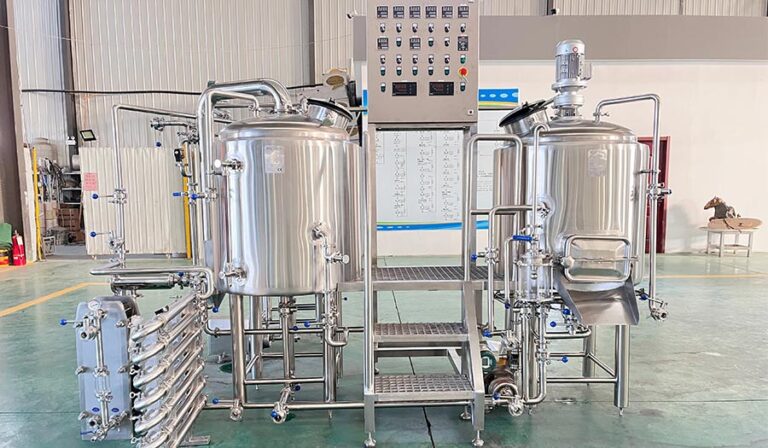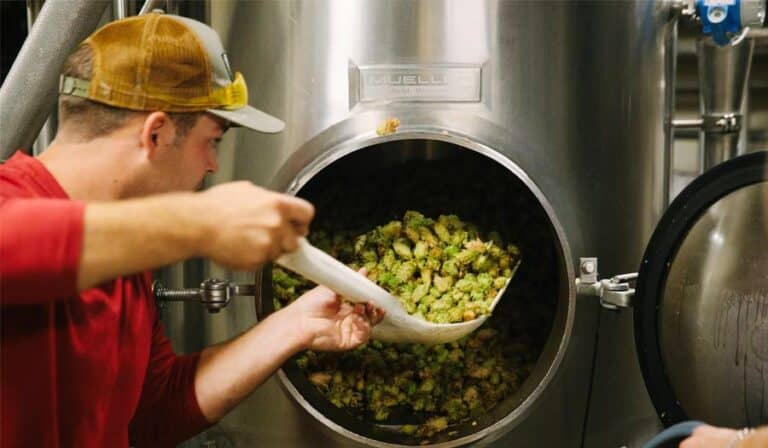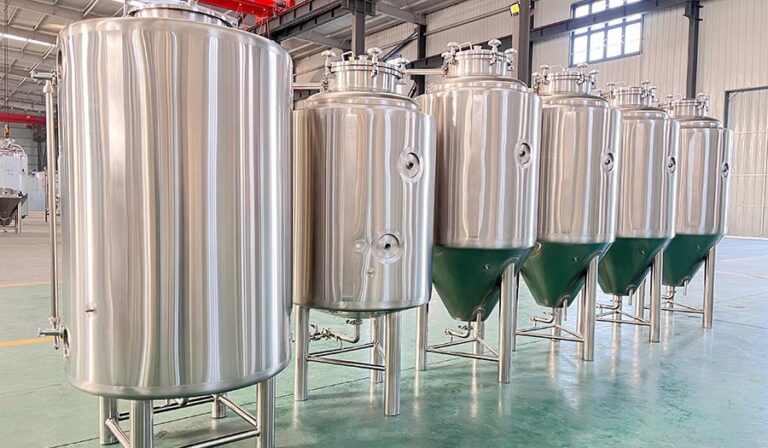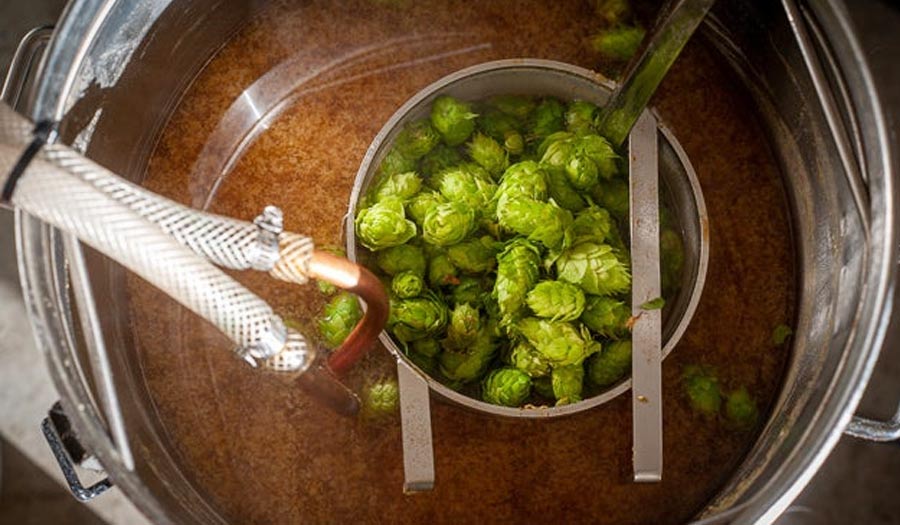Mit dem Aufkommen der Craft-Bier-Kultur versuchen immer mehr Menschen, ihr Bier selbst zu brauen. Heimbrauen bringt nicht nur ein köstliches Erfolgserlebnis mit sich, sondern ermöglicht es auch, die Freude an der Schöpfung zu erleben und sein handgemachtes Bier zu genießen. Der grundlegende Prozess des Bierbrauens ist kompliziert, aber für Anfänger, solange sie die grundlegenden Brauereiausrüstung und den Prozess kennen, können sie leicht loslegen. In diesem Leitfaden stellen wir den grundlegenden Prozess des Bierbrauens, die erforderliche Ausrüstung und einige praktische Fertigkeiten im Detail vor, um Anfängern zu helfen, ihr Bier von Grund auf zu brauen.
Was ist selbst gebrautes Bier?
Selbstgebrautes Bier wird von Privatpersonen zu Hause oder in einem kleinen, unabhängigen Raum unter Verwendung von Rohstoffen (z. B. Wasser, Malz, Hopfen und Hefe) und der entsprechenden Ausrüstung im Rahmen eines bestimmten Brauprozesses hergestellt. Im Vergleich zu gewerblich gebrautem Bier ist selbst gebrautes Bier in der Regel individueller und vielfältiger, da der Brauer das Rezept frei wählen und nach persönlichem Geschmack und Vorlieben anpassen kann.
Merkmale von selbst gebrautem Bier:
- Personalisierung: Jeder Heimbrauer kann je nach seinen Vorlieben verschiedene Rohstoffe und Brauverfahren wählen, um ein Bier mit einem einzigartigen Geschmack zu kreieren.
- Experimentell: Selbstbrauer haben oft mehr Spielraum, um verschiedene Rezepte und Verfahren auszuprobieren und verschiedene Experimente durchzuführen, was den Prozess des selbstgebrauten Biers voller Spaß und Überraschungen macht.
- Tradition und Kultur: Selbst gebrautes Bier hat eine lange Geschichte, und in vielen Kulturen gibt es eine Tradition des selbst gebrauten Biers. Der Brauprozess kann auch eine Form von Gemeinschaftsaktivitäten oder Familienzusammenkünften sein.
- Lernen und Erfolgserlebnisse: Durch selbst gebrautes Bier können die Brauer den Prozess der Bierherstellung verstehen und ihr Verständnis für die Bierwissenschaft und -kultur erweitern. Gleichzeitig kann das erfolgreiche Brauen einer Charge guten Biers große Befriedigung bringen.
- Erschwinglich: Obwohl die Anfangsinvestitionen höher sein können, ist das Heimbrauen auf lange Sicht in der Regel kostengünstiger als kommerzielles Bier, vor allem, wenn Sie anfangen, in Chargen zu produzieren.

Grundlegende Zutaten für das Heimbrauen
- Malz: Liefert vor allem Zucker, in der Regel Gerstenmalz, aber auch andere Getreidesorten wie Weizen, Roggen usw. können verwendet werden. Die Brauer verwenden Stärke, um Zucker zu bilden und schließlich Alkohol zu produzieren. Gemälzte Gerste oder Malz ist das bevorzugte Getreide für Brauer, um Bier zu brauen, obwohl viele andere Arten von Malz und nicht gemälztem Getreide oft verwendet werden.
- Wasser: Reines Wasser ist unerlässlich, denn es macht mehr als 85% des Bieres aus. Je besser die Wasserqualität, desto besser das Bier. Sie können auch abgefülltes Quellwasser in Gallonenflaschen kaufen.
- Hefe: Verantwortlich für den Gärungsprozess, bei dem Zucker in Alkohol und Kohlendioxid umgewandelt wird. Bierhefe gibt es in zwei Formen: Trockenhefe und Flüssighefe. Trockenhefe ist am einfachsten zu verwenden und erfordert in den meisten Fällen keine zusätzlichen Vorbereitungen. Bei Flüssighefe gibt es mehr Varianten, aber manchmal ist ein Hefestarter erforderlich, je nach der Stärke (ursprüngliches spezifisches Gewicht) der Partie.
- Hopfen: Für viele Craft-Bier-Liebhaber ist dies unsere Lieblingszutat. Hopfen ist der Schlüssel zum Bierbrauen. Er verleiht dem Bier Geschmack und Aroma und trägt dazu bei, dass das Bier länger frisch bleibt. In den meisten Fällen wird der Hopfen 1-1,5 Stunden lang in der Würze gekocht, wobei die Alphasäuren" die wichtigsten Bitter- und Konservierungsstoffe des Bieres sind.
Der grundlegende Prozess des Heimbrauens
Maischen
Das Maischen ist der wichtigste Schritt beim Bierbrauen, bei dem die im Malz enthaltene Stärke in Zucker umgewandelt wird. Im Maischbottich wird das geschrotete Malz mit heißem Wasser vermischt und bei einer bestimmten Temperatur (in der Regel zwischen 65 und 70 °C) für einen Prozess gehalten, der in der Regel 60 bis 90 Minuten dauert. Die Enzyme im Maischprozess spalten die Stärke in vergärbaren Zucker auf.
Lauting
Nach dem Maischen erhalten Sie eine dickflüssige Flüssigkeit, die "Würze" genannt wird. Als nächstes müssen Sie den Malzrückstand von der Würze trennen. Der Malzrückstand wird durch einen Filter von der Würze getrennt, der als "Filterrückstand" bezeichnet wird. Danach kann der Malzrückstand weiter mit Wasser gewaschen werden, um den Zucker zu entfernen.
Kochen und Hüpfen
Geben Sie die gefilterte Würze zum Kochen in den Maischebottich. Durch das Kochen werden nicht nur die anderen Bestandteile der Würze erhöht, sondern auch der Zucker konzentriert und Hopfen zur Aromatisierung zugegeben. Der Hopfen setzt während des Kochens Bitterstoffe, Aromastoffe und Konservierungsstoffe frei, die den Geschmack des Bieres verbessern können.
Die Kochzeit beträgt 60-90 Minuten, während der der Hopfen schrittweise zugegeben wird. Im Allgemeinen bringt der zuerst hinzugefügte Hopfen Bitterkeit, während der später hinzugefügte Hopfen dem Bier mehr Geschmack verleiht.
Kühlung
Nach dem Kochen muss die Würze schnell auf eine für die Hefegärung geeignete Temperatur abgekühlt werden (in der Regel 18-24 °C). Die Abkühlung muss schnell erfolgen, da sie sonst zu Bakterienwachstum führen kann. Verwenden Sie einen Kühler, um eine schnelle Verbindung zu ermöglichen.

Gärung
Die abgekühlte Würze kommt in das Gärfass, und dann wird die Hefe hinzugefügt. Die Hefe wandelt Zucker in Alkohol um und steigt auf, und der gesamte Prozess dauert in der Regel ein bis zwei Wochen. Während der ersten Gärung bilden sich im Gärfass Blasen, was ein Phänomen der aufsteigenden Freisetzung ist. Nach der Gärung wird der Alkoholgehalt des Bieres grob bestimmt.
Bootfahren und Konditionierung
Nach der Gärung bildet das Bier eine Lösung, und die restliche Hefe und einige Zellen setzen sich auf dem Boden ab. Das Bier kann dann in Flaschen sterilisiert und mit Zucker versetzt werden (für die zweite Gärung in der Flasche). Nach der Abfüllung muss das Bier 2 bis 4 Wochen bei Raumtemperatur gelagert werden, damit sich der Geschmack allmählich verfeinert.
Welche Braugeräte brauchen Anfänger für das Heimbrauen?
Für Anfänger ist für das Brauen zu Hause keine komplizierte Ausrüstung erforderlich, und viele Grundausrüstungen können in Bausätzen für das Brauen zu Hause erworben oder in gewöhnlichen Küchenutensilien gefunden werden. Hier sind die grundlegenden Geräte, die Sie für das Heimbrauen benötigen:
Brühgruppe
Der Kochtopf wird zum Kochen der Würze während des Würzekochens verwendet. Wir empfehlen, hochwertige Produkte zu wählen, insbesondere solche aus rostfreiem Stahl 304. Die Korrosionsbeständigkeit und die Beständigkeit gegen Hitzeschäden werden sich im Laufe der Zeit bewähren und viele Jahre lang halten.
Maischekessel
Der Maischetopf dient zum Mischen und Erhitzen von Malz und Wasser, um die Stärke im Malz in Zucker umzuwandeln. In der Regel sollte das Fassungsvermögen des Maischebehälters größer sein als das Ihres Gärfasses. Es wird empfohlen, ein Fassungsvermögen von 30-40 Litern zu wählen, um sicherzustellen, dass genügend Platz für den Maischeprozess vorhanden ist, damit dieser nicht scheitert.
Gärfass
Die Gärfass ist eines der wichtigsten Instrumente im Bierbrauprozess. Es wird verwendet, um die verzuckerte Flüssigkeit aufzunehmen und ein für die Biergärung geeignetes Umfeld zu schaffen. Anfänger können sich für Gärfässer aus Edelstahl oder Kunststoff mit einem Fassungsvermögen von in der Regel 20-30 Litern entscheiden, die den Bedürfnissen des regelmäßigen Heimbrauens ohne Massenproduktion entsprechen.
Verdampfer
Nach dem Kochen muss die heiße Würze schnell auf eine für die Hefegärung geeignete Temperatur abgekühlt werden. Bei dem Gerät handelt es sich in der Regel um ein röhrenförmiges Gerät aus Kupfer, mit dem die heiße Flüssigkeit durch fließendes kaltes Wasser schnell abgekühlt wird. Anfänger können sich für ein einfaches Fasskühlsystem entscheiden oder eine fertige Kühlvorrichtung verwenden.
Thermometer
Thermometer sind während des gesamten Brauprozesses von entscheidender Bedeutung, insbesondere während der Maische-, Koch- und Gärungsphase. Durch die Aufrechterhaltung einer stabilen Temperatur wird sichergestellt, dass jede Phase des Brauens unter optimalen Bedingungen abläuft. Es wird empfohlen, ein digitales Thermometer zu verwenden, um eine höhere Genauigkeit zu erzielen.
Flaschen und Flaschenverschlüsse
Nach dem Brauen muss das Bier zur Reifung in Flaschen abgefüllt werden. Es ist sehr wichtig, die Flaschen zu reinigen und zu desinfizieren, um sicherzustellen, dass keine Mikroorganismen zurückbleiben, da dies sonst den Geschmack und die Qualität des Bieres beeinträchtigt. Flaschenverschlüsse sind Hilfsmittel, um die Flaschenmündung zu verschließen und das Bier frisch zu halten.
Desinfektionsmittel
Während des Wacholderprozesses ist die Desinfektion der Schlüssel zur Sicherung der Bierqualität. Alle Werkzeuge, Geräte und Flaschen, die mit dem Bier in Berührung kommen, müssen gründlich desinfiziert werden, um das Wachstum verschiedener Bakterien zu verhindern. Es wird empfohlen, ungiftige Desinfektionsmittel zu verwenden, die speziell für Wacholder geeignet sind.
Trichter und Siebe
Während des Maischens und Kochens müssen Sie möglicherweise einen Trichter verwenden, um die Flüssigkeit in andere Behälter zu gießen, und ein Sieb, um Malzpartikel usw. zu entfernen, damit das fertige Bier klar ist.

Tipps zum Heimbrauen
Halten Sie Ihre Ausrüstung sauber und desinfiziert
Dies ist der grundlegendste und wichtigste Schritt. Alle Utensilien, die während des Gärprozesses mit Bier in Berührung kommen, müssen gründlich gereinigt und desinfiziert werden. Das Vorhandensein von Schimmel, Hefe oder fremden Bakterien kann die Gärung und den endgültigen Geschmack des Bieres beeinträchtigen und sogar zum Verderben des Bieres führen.
Temperatur kontrollieren
Achten Sie darauf, die Temperatur während des Maischvorgangs zu kontrollieren. Während des Maischvorgangs beeinflussen unterschiedliche Temperaturen die Umwandlungseffizienz der Stärke im Malz, in der Regel zwischen 65-70 °C. Verschiedene Hefearten haben unterschiedliche optimale Gärungstemperaturen. Achten Sie darauf, bei der richtigen Temperatur zu gären, damit die Hefe keine unerwünschten Nebenprodukte produziert.
Einen Hefestarter herstellen.
Eine gute Möglichkeit, Geld zu sparen, ist die Herstellung eines Hefestarters. Hefe vermehrt sich gerne unter den richtigen Bedingungen. Das bedeutet, dass Sie mit einem Beutel Hefezellen mehr Hefezellen vermehren können. Dieser Prozess ist einfach und dauert weniger als eine Stunde.
Bier Klärung
- Geben Sie der Würze Enzyme zu, um Proteine und Polyphenole zu entfernen, die Trübungen verursachen.
- Wählen Sie die richtigen Rohstoffe. Die Verwendung von Hochalphahopfen zur Erhöhung der Bitterkeit kann die vom Hopfen verursachte Trübung des Bieres verringern. Hopfenblätter enthalten mehr Polyphenole als Hopfenextrakt. Es gibt auch Malz mit niedrigem Polyphenolgehalt, das aber den Geschmack in gewissem Maße beeinträchtigt.
- Versuchen Sie, eine Batch-Spülung zu verwenden, die die Menge des aus der Schale extrahierten Gerbstoffs reduzieren kann.
Zusammenfassung von Heimbrauen für Anfänger
Für Anfänger ist das Heimbrauen eine interessante und kreative Tätigkeit. Bevor Sie beginnen, sollten Sie unbedingt hochwertige Rohstoffe auswählen und darauf achten, dass Sie hochwertiges Wasser, Malz, Hopfen und Hefe verwenden. Gleichzeitig müssen Sie die Geräte sauber halten und desinfizieren, um Verunreinigungen zu vermeiden. Die Beherrschung der Temperaturkontrolle bei Maische und Gärung ist ebenfalls sehr wichtig, um das ideale Aroma und den idealen Geschmack zu erzielen. Es empfiehlt sich, jeden Schritt und jedes Ergebnis zu protokollieren, damit Sie es leicht anpassen und verbessern können. Entwickeln Sie außerdem nach und nach Ihren persönlichen Stil, indem Sie mit verschiedenen Rezepten und Brautechniken experimentieren. Vergessen Sie nicht, den Gärungsprozess regelmäßig zu beobachten und sich am Austausch in der Gemeinschaft zu beteiligen, um Ihre Erfahrungen mit dem Hausbrauen zu bereichern. Kurzum, seien Sie geduldig und enthusiastisch, und Sie werden köstliche Hausgebräue und ein Gefühl der Vollendung ernten.




